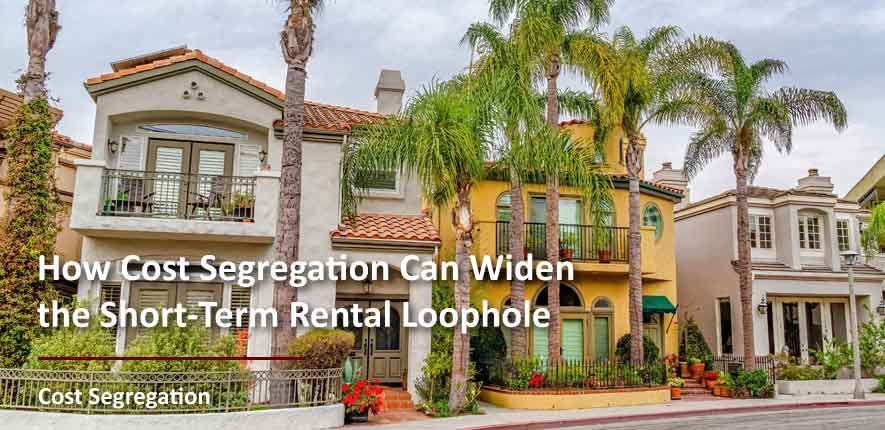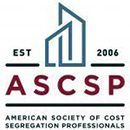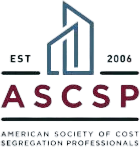How Cost Segregation Can Widen the Short-Term Rental Loophole
The following article is a republication from an article featured in Bloomberg Tax, coauthored by Alex Bagne, the President of ICS Tax, LLC. Alex Bagne holds licenses as an attorney and a CPA, along with having earned an MBA. He is also a Certified Cost Segregation Professional and has held the position of President of the American Society of Cost Segregation Professionals.

Certified Cost Segregation Professionals Alex Bagne, Malik Javed, and Rob Rahner illustrate how to utilize an asset depreciation strategy to maximize tax savings from the short-term rental loophole if the activity meets the “Seven-Day Rule.”
Owning and renting real estate can be financially lucrative, but when it comes to the classification of rental activities for tax reporting purposes, not all scenarios are created equal. The nature of the taxpayer’s participation in the rental activity can make a material difference in the way the income is treated, and a cost segregation strategy will enable full advantage of tax rules for property getting through the short-term rental loophole.
The Seven-Day Rule and Active vs. Passive Income
If the property owner by virtue of the rental activity meets just one of seven “material participation” tests (dis- cussed below) and the average rental period is less than seven days, the IRS considers the use of the property not as a passive rental activity but rather as an active trade or business activity similar to operating a hotel. This distinction can have significant implications as it allows for depreciation deductions that can offset active income such as wages, yielding substantial tax savings. These savings are often enhanced when cost segregation is applied.
Taxpayers have two types of income: active and passive. Active income generally includes the wages and salaries or fees earned by taxpayers as direct compensation for work done, while passive income comes from renting out properties, investing, and other activities in which the taxpayer does not materially participate. Coin-operated car washes and laundry facilities are other examples of passive businesses. Internal Revenue Code §469 generally disallows taxpayers from offsetting active income with passive losses. Thus, a taxpayer cannot offset their wages with losses sustained by rental activities as long as such losses are considered passive, which they typically are.
However, an exception to this rule can be found in Treasury Regulations §1.469-1T(e)(3)(ii)(A), which states that an activity involving the use of tangible property is not a §469 rental activity if “the average period of customer use for such property is seven days or less.” This “Seven-Day Rule” is particularly relevant for those who own and operate short-term rental properties such as vacation homes and Airbnb or Vrbo listings.
Tax Implications
When a rental activity falls under the Seven-Day Rule, its treatment as an active trade or business rather than a passive activity carries several significant tax implications:
- Property Deductions: Owners of properties subject to the Seven-Day Rule can often deduct expenses related to their rental activity from their active income, including mortgage interest, property taxes, maintenance costs, insurance and other expenses associated with the property.
- Loss Deductions: If a property owner experiences a loss on their short-term rental activity (i.e., the expenses exceed the rental income), these losses can be used to offset income from other active businesses, potentially reducing their overall tax liability.
- No Self-Employment Tax: While short-term rental income, in as far as it is active income, is generally subject to self-employment tax, which can be substantial, owners of property falling under the Seven-Day Rule can avoid self-employment tax on their rental income.
Benefits of a Cost Segregation
Cost segregation is a tax planning strategy that accelerates depreciation deductions, defers taxes and improves cash flow for real estate investments. On average, 15% to 30% of the depreciable basis of a building falls into tax categories that can be written off much faster than the building structure. For example, carpeting and vinyl flooring, kitchen cabinets, and special-purpose electrical equipment typically qualify as personal property that is depreciated over five years instead of the usual 27.5 or 39-year depreciable lives applied respectively to residential and nonresidential real property. Land improvements such as landscaping, parking lots, site lighting and storm sewers are depreciated over just 15 years.
Both personal property and land improvements can also qualify for bonus depreciation ranging from 30% to 100% depending on the tax year the property was placed into service.
A cost segregation study should be performed by a certified professional to maximize and properly document the incentive. Such a study can address current year assets as well as those placed in service in prior tax years without the need to amend prior tax returns. Performing a cost segregation study will reduce annual federal and state in- come tax payments, potentially freeing up money that can be used for other investments or purchases.
Material Participation and Other Considerations
While the Seven-Day Rule can offer significant tax advantages, especially when paired with cost segregation, it is important for property owners to be aware of the IRS’s material participation requirements. According to IRS Publication 925, property owners must satisfy at least one of the “material participation” requirements listed therein as to a given tax year:
- You participated in the activity for more than 500 hours.
- Your participation was substantially all the participation in the activity of all individuals, including individuals who did not own any interest in the activity.
- You participated in the activity for more than 100 hours and at least as much as any other individual (including individuals who did not own any interest in the activity).
- Your participation in the activity is a “significant participation,” meaning more than 100 hours but not meeting any other material participation test, and your total time on significant participation activities exceeded 500 hours.
- You materially participated in the activity for any five years (whether or not consecutive) out of the 10 im- mediately preceding tax years.
- The activity is a “personal service activity” in which you materially participated for any three consecutive or nonconsecutive preceding tax years.
- Based on all the facts and circumstances, your participation in the activity was “regular, continuous, and substantial.”
For test 6, “personal service” means the activity is performed in a field such as health (including veterinary services), law, engineering, architecture, accounting, actuarial science, performing arts, consulting, or any other trade or business in which capital is not a material in- come-producing factor.
Owners of short-term rental properties should maintain thorough financial records to comply with IRS regulations. Additionally, property owners should be aware of local laws and regulations governing short-term rentals, as they may have their own tax implications.
Taxpayers also need to determine the proper depreciable recovery period of the asset. As mentioned above, real property is separated into two areas: residential rental property with a recovery period of 27.5 years and nonresidential real property with a recovery period of 39 years. Many tax professionals incorrectly assume that short- term rental properties are depreciated over 27.5 years. However, rental property used on a transient basis must be depreciated over a 39-year recovery period. If the unit is occupied more than half the days of a tax year by a tenant(s) that stays less than 30 days, as is typical for Airbnb and similar rentals, it is considered a transient basis rental. This means that most owners of short-term rentals with an average stay of under 30 days would more accurately depreciate their nonresidential real property over 39 years.
Conclusion
The Seven-Day Rule presents a valuable opportunity for short-term rental property owners to reduce their income tax liability by classifying their rental activity as an active trade or business. By taking advantage of this rule, property owners can deduct property expenses from active income, potentially offset losses against other business income and avoid self-employment tax on rental earnings. Performing a cost segregation study on the individual taxpayer’s property and circumstances can deter- mine the viability of this tax position and may open up additional tax savings.
While substantial financial benefits are available, it is essential to meet IRS criteria, keep detailed records, understand depreciation, and stay informed about local regulations. As always, consulting with a certified cost segregation professional and an accountant experienced in real estate can help property owners navigate the complexities of the tax code and make the most of the Seven-Day Rule.
About the Authors
Alex Bagne, JD, CPA, MBA, CCSP, is the president of ICS Tax, LLC. Malik Javed, CCSP, is a principal at KBKG, Inc. Rob Rahner, CFA, ASA, CCSP, is the managing director for Cost Recovery Solutions, LLC. All have served as board members of the American Society of Cost Segregation Professionals, a non-profit corporation attending to the growing need for education, credentials, technical standards, and a code of ethics within the CS industry.
This article was published on Bloomberg Tax
How Cost Segregation Can Widen the Short-Term Rental Loophole
This article was published on ICS Tax, LLC
How Cost Segregation Can Widen the Short-Term Rental Loophole



